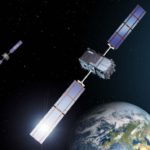
On December 12, four Galileo satellites started their journey on an Ariane 5 rocket from the European Spaceport in Kourou. Shortly after leaving the rocket, the satellites – named Nicole, Zofia, Alexandre and Irina – reached stable configuration and established first contact with Earth.
This launch marked the first time that the European GNSS Agency (GSA) was responsible for the Early Orbit Phase (EOP) of the mission. EOP is one of the most important phases of a space mission as it positions the satellites into the correct orbits and gradually switches on and tests the first elements. For example, just days after the launch, the four satellites were transitioned from sun acquisition mode to Earth tracking mode, also known as nominal operational mode (NOM). In this mode, the satellites point to the Earth with all antennas oriented towards the ground.
Next, the satellites began moving to their destination Galileo orbit with a set of very precise manoeuvres, with Nicole and Zofia reaching their final target orbits on February 6, and Alexandre and Irina following suit on February 14. With all four satellites in their final slots, EOP came to an end on February 26.
Time for In Orbit Testing
The quartet of Galileo satellites are now starting the In Orbit Testing phase, a comprehensive characterization and evaluation of the satellites’ behaviour in space. Although extensive tests were performed before launch, the space environment cannot be fully represented on ground, and thus extra testing in space is necessary. This includes transmitting test navigation signals, whose performance will be carefully monitored and tested. The performance tests ensure that the satellites’ in-orbit performance is in line with the predictions made during on-ground testing.
Once the performance testing is concluded and deemed satisfactory, the satellites will enter into service as part of the Galileo constellation – bringing the total number of satellites to 22.
